Keynotes 6
The Qin Dynasty: Political Unification Under Imperial Rule
In
221 B.C.E. China was unified under the Qin dynasty.
The basic but considerable difference between the state of Qin
and the states that had been conquered was that privileges of the nobility
were abandoned and officials who were assigned for government positions were
selected according to merits.
The nobility of the states that had been overcome by Qin had to move to the
capital Xianyang, where they lived under immediate control of the imperial
administration. The ancient feudal past came to an end and was followed by
the imperial period of Chinese history.
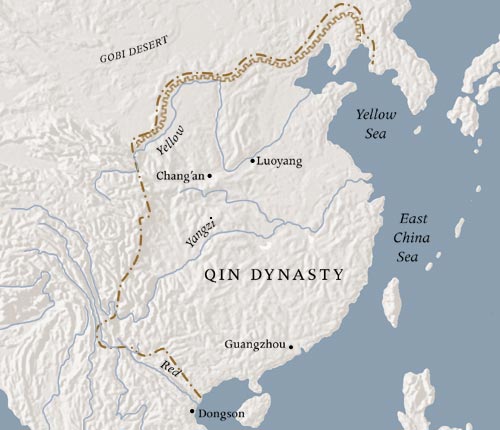
The state of
Qin
The
question of the best philosophy for ruling as it had been asked many times
by rulers in the Warring States period of contending powers was not asked
by the first emperor, nor was the morality of the ruler discussed. The ideology
of Legalism was based on the assumption that the nature of man is evil (first
declared by the Confucian philosopher Xunzi). Legalist philosophy considered
the strict control over the observation of laws by the people as necessary.
This ideology formed the basis of the first emperor’s rule.
More
than questions of the quality of a rule, a matter of concern discussed in
the elite circles, were how to deal with opposition and - on the other side-
how to express it, as well as how to solve economic problems and how to recruit
capable officials.
Legalist
ideas had been taken up by the Qin minister Shang Yang (his Book
of Lord Shang is dated 359 B.C.E.). Shang Yang had strengthened the state of Qin by pragmatical tax reforms and by dividing the people
into units of tens and fives who were supposed to supervise one another. The
group members were held responsible for each others' action in civil life
just as on the battlefield. With all households being registered,
tax income and recruitment for military service could easily be controlled
by the authorities. The population was divided into
20 ranks, all instantly recognizable by the color of their clothing. The amount
of land and slaves an individual could own and the style of housing was also
regulated. The land was taxed with a share of the crop.
Less
pragmatic but also inspired by legalism were the writings by Han Feizi
(280-233 B.C.E.) – the
first among the famous philosophers of ancient China whose teaching was recorded by himself
instead by his disciples. Shang Yang’s measures and Han Feizi’s ideology prepared the basis for the rule of the first
emperor. According to the teachings of Han Feizi strict laws and punishments
were the essential basis for the state to keep law and order. Education was
not a major concern of the Qin government though a certain level of qualification
was required for state positions since merit was more important than birth
in order to obtain a position in the administration. More important were agriculture
as the basis of the economy and the military to expand the territory of the
state.
In
order to consolidate his power the Qin emperor standardized
- the
script,
- weights
and measures,
- the
currency, and
- the
length of the cart axles.
- He standardized a law code which
everybody had to obey to and which prohibited the private possession of arms,
and he
- installed a state police and a secret
service as government agencies.
- Roads and canals were built to link all areas of the territory and move
soldiers and supply fast.
For
the defence of his northern border he linked the
walls that had been built by the northern states into a coherent defense system
- the Great Wall.
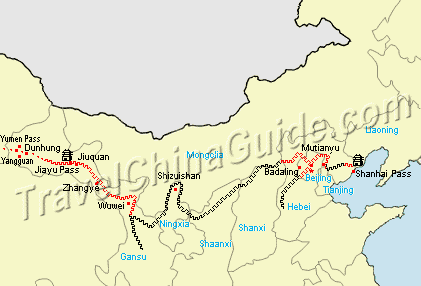
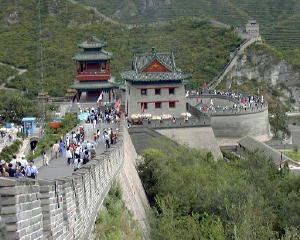
The Great Wall near Beijing
The
realm was divided into 42 commanderies which then
were divided into counties. Each commandery resembled
the structure of the central government: A chancellor headed the
bureaucracy, an imperial secretary drafted the emperor’s edicts, a grand commandant headed the military.
The
commanderies had three leading officials: the official in charge of tax collection, population
registers, and law and order. Another official controlled the application
of imperial edicts, and a commandant recruited and trained the military.
In
order to prevent nepotism and cliques officials were not allowed to serve
in their home town or district. Office clerks could be recruited locally.
Five
times the emperor toured his empire in the first ten years of his rule. On
these tours, he showed himself to the people and made sacrificial offerings
at the sacred mountains. Under the influence of Daoist advisors he tried
to find the means to gain immortality. Since the Eastern Sea was said to harbour
the island of the immortals he sent out ships staffed with young men and women
to search for this paradise. None of the ships returned. When he sensed that
his search for physical immortality could be in vain he increased efforts
to equip his mausoleum as a perfect mirror image of his mundane residence
as son of heaven.
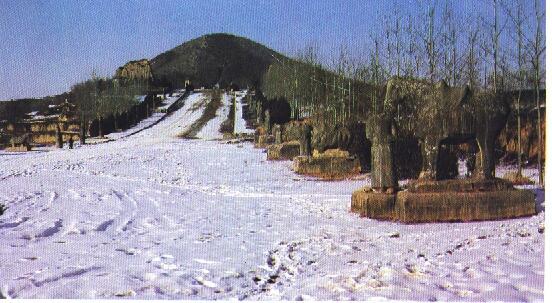
Mausoleum
of Qin Shihuang
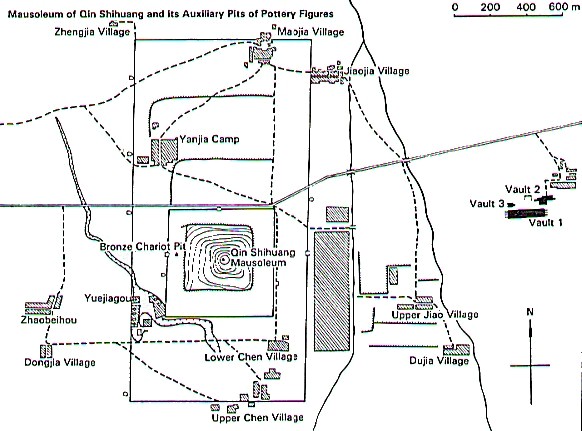
Map of the mausoleum's
surroundings
Another
costly project which required advanced engineering techniques was the irrigation
system and the system of canals distributing the water of the Min River to
prevent Chengdu from flooding and draught. It was built by Li Bing, the governor
of Shu, and his son in the vicinity of the capital of Chengdu in Sichuan.
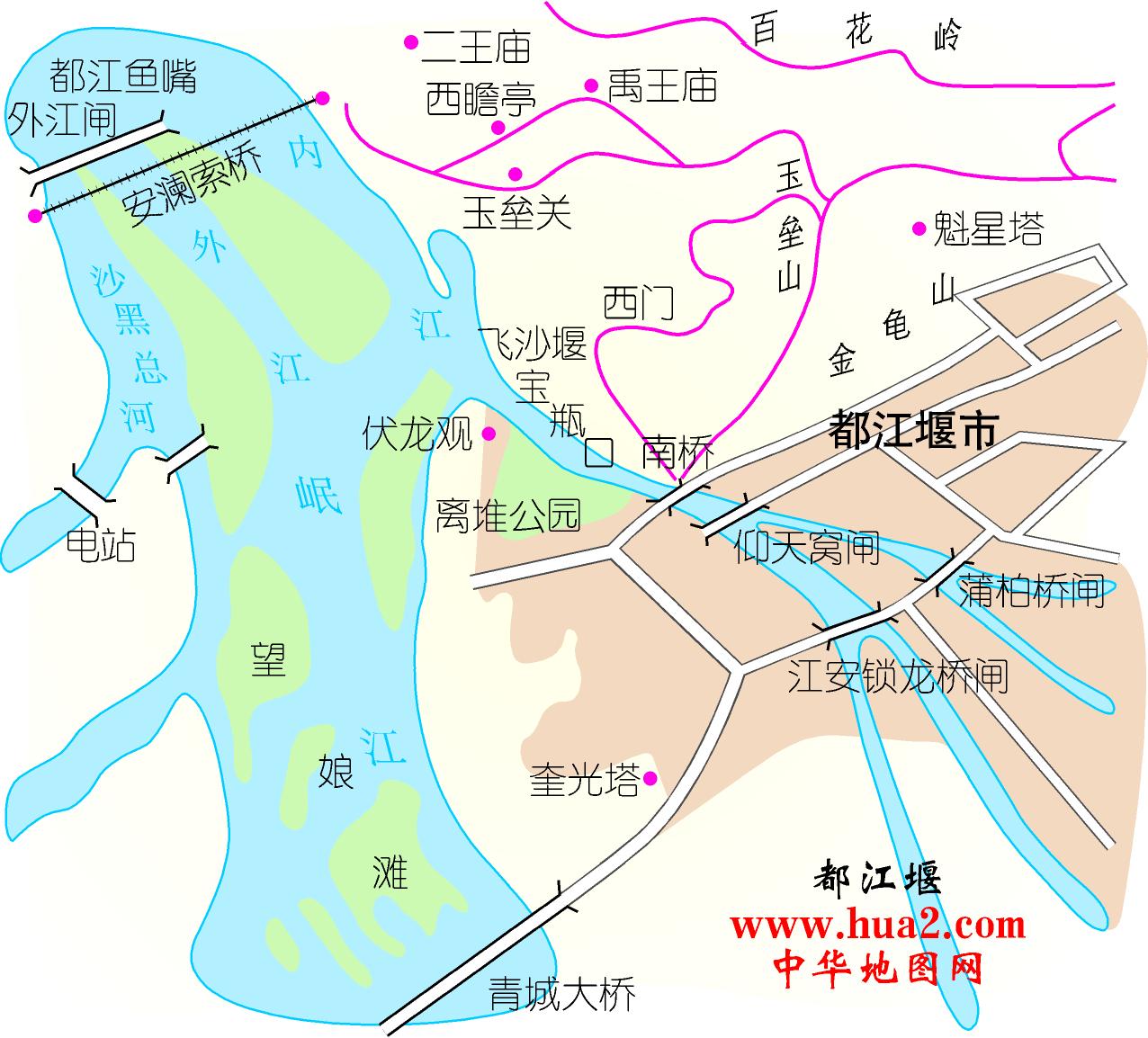
The division
of the Min River to control flooding and draught
The founding of the Han Dynasty
The
cruelty of Qin Shihuangdi’s rule and the costly
building projects as well as the succession to the throne by his second instead
of his first son after the first emperor's death in 210 B.C.E. provoked new
uprisings which resulted in the founding of the Han dynasty by the victorious
rebel, Liu Bang (r. 206-195 B.C.E.).
Liu
Bang, who had a peasant background, had been a supervisor of 1000 households
during the Qin and was well acquainted with Qin law. Though
attacking the Qin for its brutality, he retained
most of the laws because these laws allowed for a concentration of power in
the hands of the emperor. To ensure his popularity with the people he
lowered taxes and reduced labor services to one month per year.
One
of the measures he used to stabilize his power was to replace the leaders
of the feudal states that had re-appeared after the end of the Qin-Dynasty
by members of his own clan. In this compromise between the centralized state
of the Qin and the feudal states of Zhou-times a new arictocracy without traditional
background secured the emperor's rule over the fourteen districts which were
directly supervised by the imperial administration. In addition there were
about 150 counties or earldoms which the emperor had assigned to meritorious
officials.
The
beginning of the Han was not only threatened by interior warfare but by attacks
from the northern neighbors, the tribal confederation of
the Xiongnu. Ultimately a peace treaty was negotiated that left the
Han with the promise to send silk, food and wine to the Xiongnu
as well as a princess for the Xiongnu leader in order to keep them from raiding Han territory.
Liu
Bang was followed by empress Lü (r. 188-180)
who reigned instead of the designated successor who then was still a child.
Described as being cruel and jealous, she had four potential successors killed
in order to remain in her powerful position until her death. During her rule
she received the offer of getting married by a Xiongnu
leader. Being a widower himself he declared his intention to get married to
her, because she was widowed as well. His clever attempt to obtain power without
war was declined by Empress Lü. But she realized that her position
was challenged not only by contenders but by the despised 'barbarian' neighbors
as well.
Significant
Features of 'Han' Culture
-
Writing History
-
Introduction of 'university' exams: Confucianism is institutionalized
-
Walled cities as symbols of imperial power
-
Local control through an imperial magistrate who functioned as mayor, judge,
supervisor of tax collection, and supervisor of the conscription for labor
service and military service
-
crop rotation
-
paper making
-
production of porcelain
-
production of lacquer
-
building ships with watertight compartments, multiple masts, and sternpost
rudders
-
water-powered mills
-
magnetic compass
-
wheelbarrow
-
horse collar and breast strap
Regional Rulers: Marquis
Li Cang (d. 186 B.C.E.) and his wife, Lady Dai (d. after 168
B.C.)
In 1972 a sensational discovery of a tomb was made in Changsha, Hunan
province. It was the tomb of Lady Dai. Her corpse was found perfectly preserved
in a set of four interlocking coffins and twenty layers of shrouds. A house
for the afterlife her tomb contained any luxury articles considered desirable
in life – from embroidered colorful silk gowns to 154 lacquer dishes, 51 ceramics,
48 bamboo suitcases of clothing and household goods, baskets of gold pieces
and bronze coins.
Lady Dai was also given an inventory that listed all objects as well as
the food and beverages provided for her. Rice, wheat, barley, millet, soybeans,
red lentils, thirteen different meat dishes made from a variety of seven kinds
of meat.
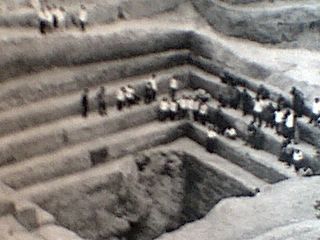
From the excavation report we learn that Lady
Dai was 1.54 m [5 feet] tall and weighed 34.3 kg [75 lbs].
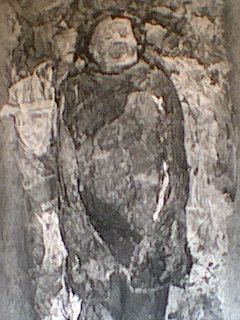
The T-shaped silk banner that covered the coffin of Lady Dai gives
insight into Han ideas about the afterlife.

The
lower section of the banner shows the offerings and ceremonies devoted to
her body soul (po). Sacrificial vessels are provided for her and attendants
are standing next to her, ready to serve her soul which resides in the tomb.
Beneath the tomb we get a glimpse of the creatures living in the underworld:
A deity of the earth carries the foundation of the tomb, her netherworld dwelling.
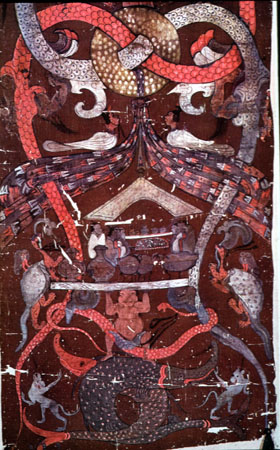
The
central part of the banner shows Lady Dai in a standing position. She leans
on a cane, while two persons crouch or kneel in front of her and three women,
presumably female attendants, stand behind her.

The upper part of the banner is said to
show the realm of the immortals. The entrance is guarded by two deities holding
the records of the life span of Lady Dai. They
are identified as deities of destiny.
In the top section we can see a standing
woman. She is surrounded by a creature with a snake-like body and flanked
by the depictions of the moon with a toad and a rabbit (which is said to pound
the elixir of immortality) and the sun with a raven. Five birds seem to keep
her company which may represent the figures of the lower parts of the banner.

The
scenes are interpreted as showing the modes of existence of the soul after
death.
The
corpse is placed in the tomb where it is served by underworld attendants.
The body soul enjoys and consumes the burial objects and offerings.
At
the same time the spirit soul (hun)
ascends to the realm of the immortals and seems to rejuvenate during this
process.
The
tomb of Lady Dai's son, who died in the same year, contained more revealing
material. While alive he most likely served as a military official and therefore
was given three maps. One of them shows the area of the tomb, another one
shows the area between the territory of the King of Changsha and the territory
of the people of the Southern Yue. The Southern Yue had been attacked by the
Han in 181 B.C.E. when the Han successfully attempted to expand their territory
to the south and southwest.
In
addition to the maps text manuscripts were found in the tomb. A copy of the
Yijing, a copy of the Daodejing in two halves, texts on law,
fortune-telling, as well as writings on sexual techniques accompanied Lady
Dai's son to the underworld.
The
text on law is of particular interest because it describes obligations of
the ruler: Punishments have to be balanced with rewards, the ruler may not
indulge in consumption, and wars may only be started for a just cause.
The
expansion of the Han Empire under Han Wudi (141-87 B.C.E.)
Under
the reign of Emperor Wu the empire reached a vast territorial extension which
would only be surpassed by the Manchurian Qing dynasty. The first campaigns
were directed to the southwest: The territory of modern North Vietnam was
brought under Han control. Then campaigns led the armies to the northwest
and southern Manchuria as well as northern Korea were subjugated (108-109
C.E.). Yet the control was not permanent: When the Han collapsed both territories
became independent, though Korea remained in close contact with China through
tributary missions.
International
trade via the silk route began to establish, silk being one of the most important
goods that was traded. Han settlements of soldier-peasants were installed
along the border to prevent raids of caravans by non-Chinese neighboring peoples.
Grapes and alfalfa sprouts found their way to China through Zhang Qian, a
general who had been sent out to establish friendly ties with nomads against
the powerful Turk Xiongnu. He was captured and held as a prisoner until he
successfully escaped after 10 years.
Although
trade connected the empires of Rome and Han China, a direct exchange could
not be established. All trade was conducted through Parthian middlemen.
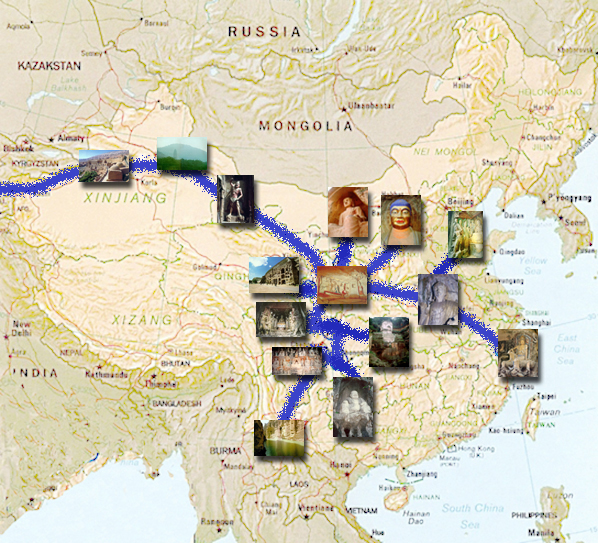
The
Han state was based on Confucian and Legalist principles: Households had to
pay taxes, provide workers for the corvée service, and soldiers for
the army. The officials were recruited from the Confucian scholars who had
to study the Five Classics and were tested before they were appointed to an
office.
Like
the Zhou, the Han began to suffer from internal instability about 200 years
after their dynasty was first established . They moved their capital further
west, to the former Zhou capital Luoyang and managed to retain power until
220 C.E.
During
the Han urbanization of local administrative centers developed: The centers
were walled cities with city gates and housed the seat of institutions of
the bureaucracy. Markets in the cities were supervised by the government,
which included the control of prices.
Major
technological achievements were the invention of the water-powered mill, the
wheelbarrow, the watertight compartment in ships, the sternpost rudder, and
the magnetc compass. Intellctual monuments were the historiographical writings
by the Grand Historian Sima Qian (d. 68 B.C.E.), and the historians Ban Gu
(d. 92 C.E.) and his sister, Ban Zhao. Ban Zhao completed the History of the
Han Dynasty, which had been begun by her brother, and wrote her own book which
served for the education of women in a Confucian mode for centuries and was
titled The Seven Feminine Virtues.












